Tech3Rs: Issue 16 (December 2022)
In this issue we share we share guidance on refining high-yield mouse behavioural studies, summarise two 3Rs papers and showcase a unit’s work on refining rat care. We also highlight IAT Congress 2023, including the NC3Rs workshop on environmental enrichment and a webinar recording on a low dead space needle developed during an NC3Rs CRACK IT Challenge.
In this issue
Refining mouse behavioural studies
A new paper and online resource to help animal technicians and researchers implement refinements for mice used in high-yield behavioural experiments.
‘High-yield’ studies can take place over weeks or months, with mice performing tasks over a high number of experimental trials. This approach is used to collect behavioural data and record brain activity, which typically involves mice being restrained by their head using a surgically implanted device. Fluid control, where access to water is restricted, is used to motivate the animals to stay engaged with the tasks and give repeated responses. Head restraint and fluid control are individually stressful to mice, but often these procedures are used together, compounding the negative welfare effects.
To address the lack of guidance on refining these methods, we brought together NACWOs, facility managers, vets and researchers. This expert group has authored a paper and created an accompanying webpage. These resources can be used to improve postoperative outcomes, health monitoring, long-term husbandry and the overall welfare of mice used in high-yield behavioural experiments. Much of the content can also be applied to rats.
The paper outlines welfare concerns, highlights humane endpoints, and provides practical recommendations for refining head fixation surgery and motivational techniques. The online resource contains practical tools, such as a detailed surgical standard operating procedure for head fixation and welfare assessment templates for monitoring mice following surgery and during fluid restriction.
To learn more about refining head fixation surgery, motivational techniques and behavioural set-ups read the paper: Barkus et al. (2022). Refinements to rodent head fixation and fluid/food control for neuroscience. J Neurosci Methods 381:109705. doi: 10.1016/j.jneumeth.2022.109705
To download a surgical standard operating procedure (SOP) and welfare monitoring templates visit the online resource: www.nc3rs.org.uk/refiningrodent-behavioural-studies
Tech Journeys: Selina Ballantyne
In this issue we are featuring Selina Ballantyne, Licence Manager at the University of Cambridge, who talks about her career to date and what she has gained from different roles.
I knew from a young age that I wanted to work with animals and as I got older I developed an interest in science. I was inspired to become an animal technician at sixth form college following a talk about animals in research and the 3Rs. My career started in 1999 as a junior animal technician, working with mice at the Medical Research Council (MRC). I progressed to become a licenced technician, gaining my Institute of Animal Technology (IAT) qualifications up to membership level. In 2006 I moved to Cancer Research UK (CRUK) as a supervisory technician.

Seizing opportunities and finding direction
Motivated by my passion for animal welfare and the scientific importance of implementing the 3Rs, I started to act in recognised roles. Being a NACWO allowed me to take a hands-on approach and implement refinements on a daily basis. As a Named Information Officer – or NIO – I continued to actively apply the 3Rs and expand my knowledge. I also spent time as secretariat for the Animal Welfare and Ethical Review Body (AWERB), which provided a great opportunity to learn from others. In 2013 I took what some might consider a sideways step, moving to the Sanger Institute as a Principal Animal Technician.
I gained something that enhanced my skill set from each of these positions, further increasing the opportunities that were available to me. My advice for junior technicians is to seek out new roles wherever you can. You might discover that you have a talent in an area that you have not considered before, or you might find that it is not the right path for you. Either way, your expertise is growing and you are becoming an increasingly well-rounded professional.
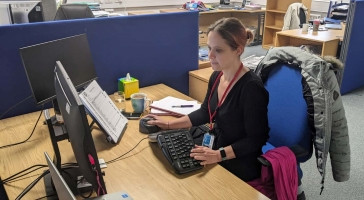
Animal welfare and regulation have always been my passions and teaching, training and talking (the 3Ts) allowed me to find a direction that I find immensely rewarding. Without trying new things I would never have discovered how much I love to educate and support others. My growing roles at the Sanger Institute as a NACWO, Animal Welfare Manager and then Senior Animal Welfare Manager provided an excellent framework to develop this side of my career. It excites me to share my 3Rs knowledge and to nurture the development of others. Animal technicians are in such an important position for advancing the 3Rs and, with the right support, the upcoming generation might be the ones to make the next big 3Rs breakthrough.
Being open to new ideas
From continually seizing chances to engage in applying the 3Rs I have learned the importance of being open to new ideas. My advice for anyone who wants to create positive change is keep an open mind. Be prepared to explore new ideas and allow them time to work, even when you are sceptical. When you give something a fair try the results can surprise you.
I applied this advice to my own work in 2019, when I lead on the development of a new incident management system using Root Cause Analysis (RCA). When we are faced with problems, such as animal welfare challenges, we often use a ‘sticking plaster’ to deal with surface issues. RCA is a method of solving a problem by identifying and addressing the source of the issue to reduce the risk of it occurring again. At first this approach was uncomfortable; it involves having difficult conversations about what went wrong and what could have been done differently. It was important to get everyone on board, be supportive and build trust. Now we have a system that gives animal technicians a voice and shows them that their input is valuable. This has resulted in some big refinements and was how we produced the Malocclusion in mice education package on the NC3Rs website.
My continued commitment to the 3Rs and pushing myself outside of my comfort zone has led to unexpected projects and recognition. My latest endeavour saw me volunteering to record a podcast episode for the series ‘Say That Again Slowly’ as part of the Cambridge Festival. The episode was entitled Animals in Biomedical Research Replacement, Refinement, Reduction. I did not expect much to come of it, so I was surprised when the episode made it onto YouTube and was then picked up and added to the NC3Rs website – this was an exciting and humbling experience.
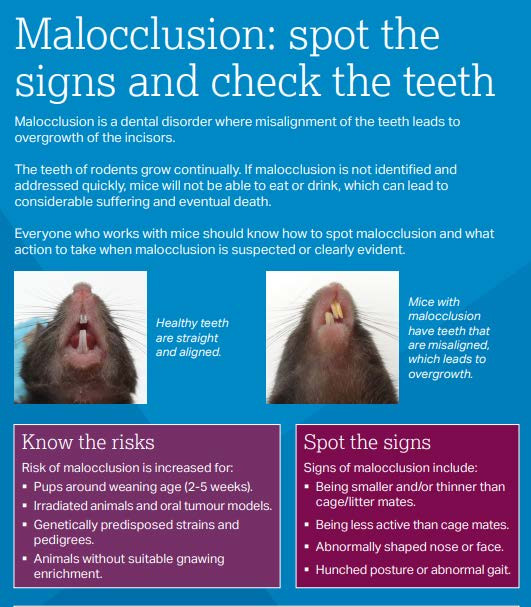
Looking back over the Tech Journeys of other inspirational role models in our sector, I realise that my story has taken me down a path that is a little different. I hope that this shows you that there is no set route to a career and that there are a variety of ways that you can apply your abilities to championing the 3Rs. Throughout your own journey I encourage you to never stop learning, be open to constructive criticism and seize all the opportunities that come your way.
Would you like to be featured in our next issue, or find out more about the refinements featured above? Please email tech3rs@nc3rs.org.uk
3Rs papers of interest
A guideline proposal for mice preparation and care in 18F-FDG PET imaging
- The authors propose a standard protocol for preparing and caring for mice in studies using fluorodeoxyglucose (18F-FDG) labelled positron emission tomography (PET) imaging. General and study-specific guidance (e.g. for oncology, cardiology and neurology studies) is outlined for improving animal welfare and imaging results.
- Keep fasting duration as short as possible. Four hours is sufficient to achieve stable blood glucose. Measure blood glucose before administering 18F-FDG to help standardise results. Pick mice up using a tunnel to minimise handling stress.
- When fasting mice, remove bedding material to prevent ingestion, ensuring that heating devices and careful monitoring are used to prevent hypothermia. Water and environmental enrichment, such as a shelter, should always be available.
- Imaging sessions should not exceed three hours in a 24-hour period or five sessions in a 14-day period, with no more than one session per day.
- Following imaging, disinfect the bed of the PET to prevent disease transmission and radioactive contamination. Monitor the vital signs of mice in recovery and ensure they have access to fluids and nesting material.
Read the paper: Ribeiro FM et al. (2022). EJNMMI Research 12:49. doi: 10.1186/s13550-022-00921-y
Refining restraint techniques for research pigs through habituation
- The study aimed to refine restraint techniques for Göttingen minipigs by habituating pigs to human socialisation and hammock sling restraint using positive reinforcement.
- 44 four-month-old pigs (22 male/22 female) were randomly assigned to a control (no training) or treatment group. Treatment group pigs had three-minute training sessions three times per week over 11 days.
- Blood was collected from all pigs while sling restrained on day 13. Time spent struggling and vocalising, and serum cortisol levels were recorded. Human approach tests were performed one day before and after blood collection.
- Although no behavioural differences were seen between groups while in the sling, trained pigs had significantly lower cortisol levels than control pigs. They were also quicker to approach handlers and spent more time in contact with observers following blood collection.
- Habituation using positive reinforcement is an effective way to reduce pig stress during and following procedures.
Read the paper: O’Malley CI et al. (2022). Frontiers in Veterinary Science 9:1016414. doi: 10.3389/fvets.2022.1016414
3Rs champion, Joanne Mains: Refining rat care
We spoke to Joanne Mains, a Senior Animal Technician at the University of Dundee’s Medical School Resources Unit (MSRU), about providing rats with playroom access and coming up with solutions to welfare challenges.
From playpens to playrooms
Following on from our success with our guinea pig playrooms and hoping to provide even greater floor space for our rats to explore and exercise, we created a dedicated rat playroom. We considered practical aspects, like fitting a door barrier to prevent escapes and ensuring that items were easy to clean before getting creative with what we had available. Almost all of the equipment we used for the playroom was found around the facility or obtained as free samples. We furnished the room with items that we knew would allow rats to express their natural behaviours. Rats love to burrow and climb and so we created tunnels with old lab coat sleeves, provided a digging box filled with soil (we buy soil for potting plants, which can then be autoclaved) and converted an old housing unit rack into a climbing frame.
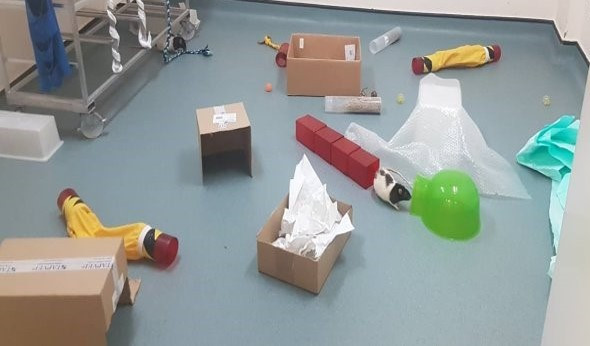
We already house our rats in larger cages than standard and provide a variety of enrichment in their home cages, but we’ve still seen additional benefits from having a dedicated rat playroom. One of the biggest differences has been the ability to get down on the floor with the rats and bond with them on their terms. We’ve found that our Lister hooded rats love to interact with humans – they’re more interested in us than they are in the enrichment or each other! As soon as you sit down on the playroom floor, they want to climb on you and be stroked.
The Sprague Dawleys prefer to socialise with other rats and are naturally more fearful of humans. Spending time in the playroom has helped them to become more relaxed and easier to handle. We think that this is due to the greater exposure they have to humans who are either in the playroom or just passing by it, and the positive association between handling and the playroom.
Working around challenges
Not every unit has space for a designated playroom of this kind. In fact, we will be merging units soon and after the move it is unlikely that we will have a room available just for our rats. As animal technicians we know that when obstacles like this come up it is our job to consider how we can work around them and focus on coming up with solutions that suit everyone, including our animals.
We don’t want the rats to lose the opportunity to climb as we know that they are highly motivated to do this. This is based on our own observations but is also backed up by a study [1]. Our initial plan will be to revert to using a playpen (an enriched enclosure rather than an entire room). The playpen will still be larger than their enriched home cages so we can include a wider variety of items and ensure that climbing enrichment is provided. We’re used to problem solving as a team, coming up with ideas and trialling them, so I have no doubt that we can work round whatever new challenges we face to keep making refinements for our rats.
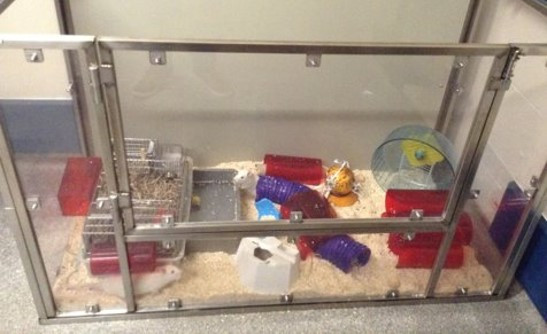
Applying old solutions to new problems: pair-housed post-operative boxes
In our original post, we shared how we refined our approach to separating mating pairs using a tube and Perspex barrier. We have now applied a similar approach to give our male Sprague Dawley rats social contact following dual catheter surgery. We found that group housing rats after surgery wasn’t possible as the cage mates were chewing and damaging the catheters. One option for true social housing are vascular access ports with protective caps, but these aren’t usually recommended for studies of less than two weeks. It is also necessary for staff to receive training and spend time perfecting their surgical technique whereas the approach we are currently using can be put into action immediately. It’s important to have contingency plans in place for when things don’t go to plan, if plan A (e.g. vascular access ports) doesn’t work, what is plan B – how do we ensure that we are still improving things for the animals? Our plan B has been to improve our caging.
Inspired by the success we had separating mating pairs while maintaining some sensory contact we created new post-operative boxes, with the help of our handyman Jim. This modified caging is made from clear plastic storage containers that are tall enough to allow the rats to rear to their full height. To create a partition, Jim drilled holes into some clear plastic and fixed it securely to split the box into two sections. We then bought some generic rodent bottles from pet shops and used tunnel clips to fix them to the inside of the box. Food was placed in a glass bowl inside the box.
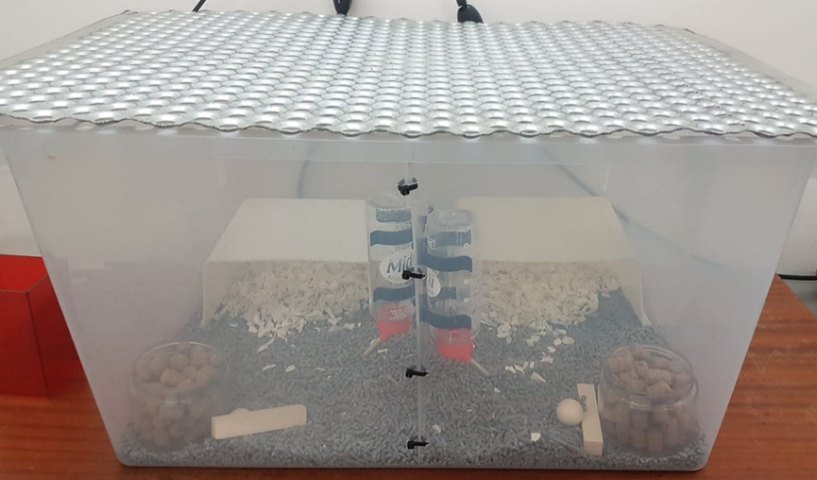
The safety of the animals is the key consideration for projects like these. We have designed the boxes with enough space for the rats to stand up and move around while minimising the risk of the catheters catching on anything. For shelters, we halved some large mouse cage bottoms to accommodate the catheters. If you decide to follow a similar approach to ours make sure that the lid is secure. We use metal sheeting from an old autoclave rack, it has large holes perfect for air but not large enough for the rats to escape. It is heavy enough that the rats cannot move it and safe enough that they cannot hurt themselves on it.
The rats can see and smell each other and will sleep next to each other on either side of the partition. We can see an improvement in our rats and had the following feedback from a researcher:
“When comparing the animals’ behaviour to those housed singly, the rats housed in the new post-operative boxes were much calmer and returned to their presurgery weights within a few days. This new approach greatly improved animal welfare and the quality of our data.”
Visit www.nc3rs.org.uk/ratplaypens for advice on how to set up a playpen in your facility
For research demonstrating the positive welfare benefits of playpens for rats, read our news story at www.nc3rs.org.uk/playpenstudy
References
- Makowska IJ and Weary DM (2016). The importance of burrowing, climbing and standing upright for laboratory rats. Royal Society Open Science 3:160136. doi: 10.1098/rsos.160136
Updates from the NC3Rs and beyond
Webinar recording: Sharp and to the Point – A precise, low dead space needle with improved animal welfare
Single-use needles, as the name suggests, are designed to be used once. If they are reused, there is a risk that they will dull and cause animals pain, as well as potentially transferring tissue products or spreading infection between animals.
The Precision Injection System, a product developed by Active Needle Technology Ltd for the NC3Rs Sharp and to the Point CRACK IT Challenge, allows needles to be changed quickly and safely between injections. The system is highly efficient, reducing the time to administer sharp and sterile injections to large groups of animals and minimising the waste of valuable injectable material by virtually eliminating dead space within the syringe. The high accuracy of this technology also facilitates precision dosing, delivering an accurate amount of injectate to the intended delivery site in a repeatable way.
Watch the webinar recording to learn more about the practical, scientific and welfare advantages of using the Precision Injection System.
Read our blog posts on the single use of needles and download a poster for display in your facility.
Institute of Animal Technology (IAT) Congress: 21 – 24 March 2023
Attending IAT Congress is a great opportunity for animal technicians to advance their professional skills and knowledge, showcase their commitment to animal welfare and communicate ideas and experiences to like-minded people.
The early-bird registration discount ends on 31 December 2022. The 2023 meeting will be held in a 5-star conference centre and hotel. Accommodation is included in the full attendance package, with options for single-day attendance also available.
A poster presentation can be an effective way to share your work with others. If you would like to create a poster the IAT have created guidance on how to do this, and the deadline for poster submission is 3 February 2023.
The NC3Rs will be presenting an interactive workshop on evaluating environmental enrichment, including the importance of considering the natural behaviour of animals and ways to improve the reliability of your findings.
Get an email notification as soon as the next issue of Tech3Rs is available to download. We recommend that this is then circulated to colleagues or printed out for display in animal houses.
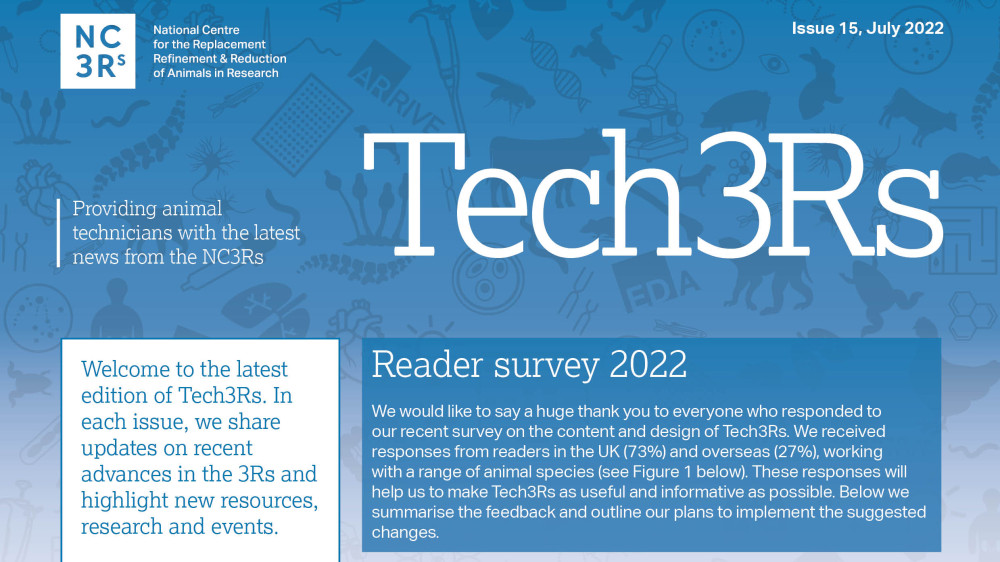
Feature in a future issue!
- Send us an idea for a feature.
- Nominate a 3Rs champion.
- Tell us about a new 3Rs approach.
- Flag a 3Rs-focused paper.
Email us at tech3rs@nc3rs.org.uk.
